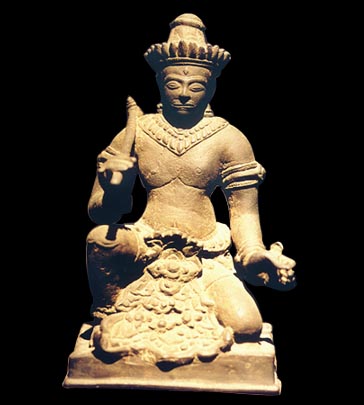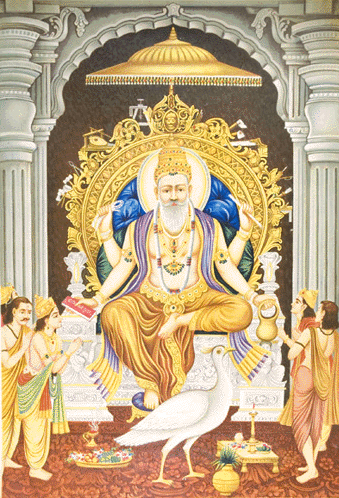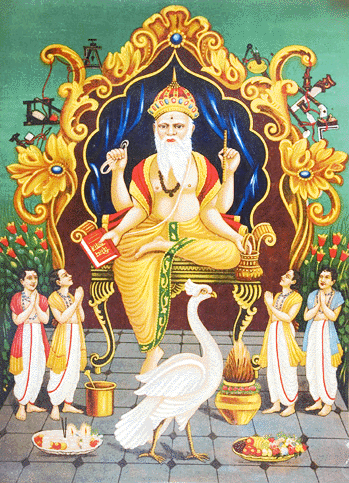Visvakarma, the Divine Architect
BY: SUN STAFF

Nov 04, CANADA (SUN) — Vishvakarma is the presiding Deity of all craftsmen and architects[1], the principal universal architect who fabricated and designed the divine architecture of the Universe at the behest of Brahma, the Lord of Creation. He is also known as Devashilpi, or 'The Architect of Gods', and is pictured in his four-armed form, carrying a water pot, a book, a noose and craftsman's tools. His mother was Yogasiddha, sister of Brihaspati, and his father was Prabhas, the eighth hermit of the legendary Astam Basu.
Vishwakarma Puja is typically celebrated a day after Diwali, when a festival in his honor is observed in factories and industrial areas, often on the shop floor. He is particularly worshipped by the engineering and architectural community, as well as by industrial houses, artists, craftsman and weavers, and other professionals.
The Rig Veda describes Visvakarma as having multi-dimensional vision and supreme strength. He is able to predict well in advance in which direction his creation will move. In later texts identified with Tvastr [2], he is the divine craftsman of the whole Universe (Rig Veda 10.81.3), and is the builder of all the demigods' palaces.

Visvakarma, Angkor Thom, 13th c. bronze
Vishvakarma is also the designer of all the vimanas, or flying chariots of the gods, as well as their weapons and divine attributes. He is said to have revealed the Sthapatyaveda, or fourth Upa-veda, and he presides over the sixty-four mechanical arts. Vishvakarma is also credited with creating the missiles used in epic battles, including the Vajra, the sacred weapon of Lord Indra, which was fashioned from the bones of the sage Dadhichi. He also designed the Triloka, the tripartite universe consisting of the material world, the heavens, and the netherworld.
In the Vedic texts, Vishvakarma is described as virad purusha, from whose navel (the padmanabha as described in later Puranas) the divine smith Twosta originated. (Dwiteeya anuvaka of Yajur veda purusha sootktha [3].)
According to the Vasishtha Purana 3.6.11, Vishvakarma created five Brahmas from each of his five faces. They are: 1) Sanaga Brahma Rishi, 2) Sanaathana Brahma Rishi, 3) Abhuvanasa Brahma Rishi, 4) Prathnasa Brahma Rishi, and 5) Suparnasa Brahma Rishi

In the Rig Veda 10.81 and 10.82, Vishvakarma is represented as the universal Father and Generator, the all-seeing who has on every side eyes, faces, arms, and feet. In the Brahmanas he is called a son of Bhuvana, and Vishva-karman Bhauvana is described as the author of the two hymns mentioned above.
In the Mahabharata and Harivamsa, Vishvakarma is mentioned as a son of the Vasu Prabhasa and Yoga-siddha. The Mahabharata describes him as "The Lord of the Arts, Executor of a thousand Handicrafts, the Carpenter of the Gods, the most eminent of Artisans, the Fashioner of all ornaments ... and a great and immortal God..."
In the Puranas he is known as the son of Vastu and the father of Barhishmati and Samjna, and elsewhere he is said to be the husband of Ghrtaci. The Ramayana represents him as having built the island of Lanka for the Rakshasas, and as having generated the ape Nala, who made Rama's bridge from the continent to the island.

Architectural Wonders
There are many architectural accomplishments ascribed to the hand of Vishvakarma. Throughout the four yugas he constructed numerous towns and palaces for the demigods, including: Swarglok (Heaven) in Satya Yuga; Lanka in Treta Yuga; Dwarka in the Dwapar Yuga; and Hastinapur and Indraprastha in the Kali Yuga. Vishvakarma is also said to have constructed the Jagannath Temple in Puri.
Lanka: There is a particular story behind the construction of Golden Lanka. When Lord Shiva married Parvati, he asked Vishvakarma to build a beautiful palace for them to reside in. Vishvakarma erected a palace made of gold. For the housewarming ceremony, Shiva invited the wise Ravana to perform the grihapravesh ritual. After the sacred ceremony, when Shiva invited Ravana to ask anything in return as dakshin, Ravana, being overwhelmed with the beauty and grandeur of the palace, asked Shiva for the golden palace itself! Shiva was obliged to accede to Ravana's wish, and the Golden Lanka became Ravana's palace. Traditional sources point to Maya as the architect, and his daughter Mandodri married Ravana.
Dwarka: The capital of Lord Krishna, Dwarka was established during the time of the Mahabharata, when Krishna made it his karma bhoomi, or center of operation.
Hastinapur: In the present Kali Yuga, Vishvakarma is said to have built the town of Hastinapur, the capital of the Kauravas and Pandavas, the warring families of the Mahabharata. After winning the battle of Kurukshetra, Lord Krishna installed Dharmaraj Yudhisthir as the ruler of Hastinapur. This is a local legend not borne out by Mahabharata.
Indraprastha: Vishvakarma is also understood to have built the town of Indraprastha for the Pandavas although again, Mahabharata says the creator was Maya, the other divine architect. According to Mahabharata, King Dhritrashtra offered a piece of land called Khaandavprastha to the Pandavas. Yudhishtir obeyed his uncle's order and went to live in Khaandavprastha with the Pandava brothers. Later, Sri Krishna invited Vishvakarma to build a capital for the Pandavas on this land, which he renamed Indraprastha.
Indraprastha is described as a beautiful architectural marvel. The floors of the palace were so well done that they had offered a reflection like that of water. The pools and ponds inside the palace gave the illusion of a flat surface, with no water in them. After the palace was built, the Pandavas invited the Kauravas and Duryodhan and his brothers to visit Indraprastha. Not knowing the wonders of the palace, Duryodhan was amazed by the floors and pools, and he fell into one of the ponds. The maids of the Pandava wife Draupadi, who witnessed this scene, found it very humorous! Duryodhan was so annoyed by the laughing maids that later on, his anger grew to become a cause for the great war of Kurukshetra.

References:
1. Cave Architecture, 2007-02-15.
2. Monier-Williams (1899) p.994
3. adbhyassambhoota: prthivyai rasAcca | vishvakarmaNassamavartatAdhi | tasya tvaSHTA vidadhadroopameti | tatpuruSHasya vishvamAjAnamagre ||
Source: Wikipedia
